Full-fat, low-sugar, high-protein and gelato: A dietitian rates eight types of ice-cream tubs
When it comes to your favourite icy scoop, which tub comes out on top? Susie Burrell breaks it down.
Is a bowl of decadent ice-cream your idea of heaven? As the temperatures warm up, icy cold treats become increasingly popular, and with an ever-expanding dessert section in supermarkets, there is a growing range of options for you.
There are fundamental differences in the ways ice-cream and ice confectionery are manufactured, with each having nutritional pros and cons. The best choice for you will depend largely on your dietary goals, and how often you indulge.

Ice-cream
Not all tubs of “ice-cream” you see in supermarket freezers are technically ice-cream, which is why you will not always find the words “ice-cream” on the front of every tub if you take a closer look. To be officially classed as “ice-cream”, the base needs to be cream and/or milk with no less than 10 per cent milk fat, which gives true ice-cream its rich taste and texture. Generally speaking, the more premium, and the more the tub costs, the more likely it is that you are paying for real ice-cream, which will contain 10 to 12 per cent fat and 20 per cent sugars. While the base of most ice-creams is similar, the greater the number of flavours, confectionery or sweet additions you make, the higher the ice-cream’s overall sugar and calorie content will be.
Dietitian’s thoughts
Some may argue that you are better off enjoying a controlled serve of full-fat ice-cream occasionally, than overdoing the more processed varieties more frequently. Also keep in mind, the greater number of flavours within a serving, the more you are likely to eat it, so sticking to a single flavour such as chocolate or vanilla isn’t a bad idea either.
Common brands: Sara Lee, Connoisseur, Bulla Murray Street, Haagen-Dazs, Norco Cape Byron, Bulla Creamy Classics, Maggie Beer, Reece’s Peanut Butter Ice Cream
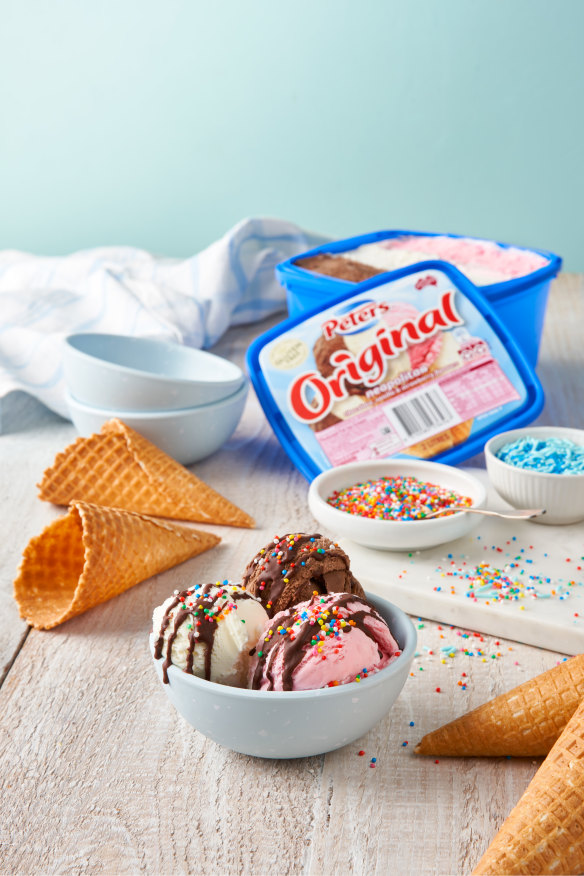
Reduced fat ice-cream
With 25 per cent less fat than regular, full-fat ice-cream, reduced fat options contain slightly less fat than regular ice-cream, but in general more sugar to create a lighter, sweeter dessert option. While lighter ice-cream options are cheaper for manufacturers to produce, as cream is relatively expensive, nutritionally a little less fat for a lot more sugar is not necessarily a good thing. In saying that, reduced fat varieties of ice-cream can cost half the amount of real ice-cream, making it a more budget-friendly option.
Dietitian’s thoughts
With 30 per cent more sugars than regular ice-cream, you could argue that for the sake of a few grams of fat, you are better nutritionally to enjoy the real stuff rather than add a lot more added sugar to your diet.
Common brands: Streets Light, Peters Original, Bulla Real Dairy Vanilla, Milo, Norco
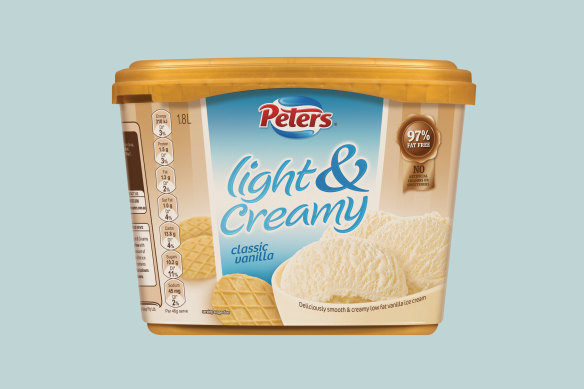
Low-fat ice-cream
While low-fat everything was extremely popular in the 1990s and early 2000s, there are only a couple of true “low fat” ice-creams, thanks to their base of skim milk and sugars. Light, low-fat ice-cream is relatively low in calories and a lighter option for those who need to follow a low-fat style of eating.
Dietitian’s thoughts
Heavily processed to create the look and taste of ice-cream minus the fat, these products generally add at least two teaspoons of sugars per serve into your diet but may be a useful option for those who specifically need a low-fat diet.
Common brands: Peters Light & Creamy, Peters No Added Sugar
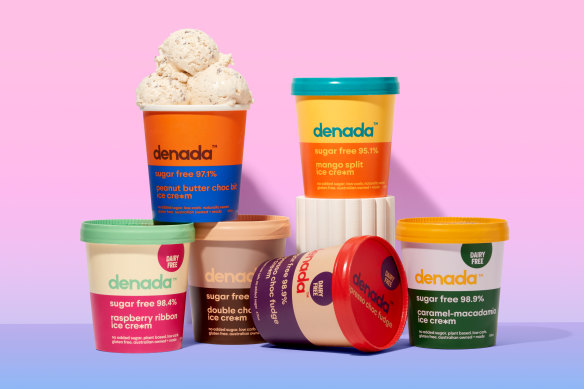
Low-sugar/low-carb
Recently, several brands that specifically offer lower-carb and sugar dessert varieties have joined the ice-cream section in supermarkets. They achieve this through the use of sweeteners and a range of additives that create the look of ice-cream for far fewer calories. While these low-carb and lower-calorie dessert alternatives may appeal to those following specific diets, ultimately they are ultra-processed foods and shouldn’t be considered a “healthier” option. Rather, most of these products are highly engineered foods that offer a taste of sweetness for minimal calories and sugars. Or, in the case of low-sugar options, high-fat ingredients such as coconut milk create the creamy taste minus the sugars. You will also need plenty of cash if you prefer these ice-cream alternatives, as they’re often much pricier than regular full-fat ice-cream.
Dietitian’s thoughts
If calorie- or carb-counting is your thing, there are certainly options for you, but you would be hard-pressed to argue they are actually healthier.
Common brands: Halo Top, Denada
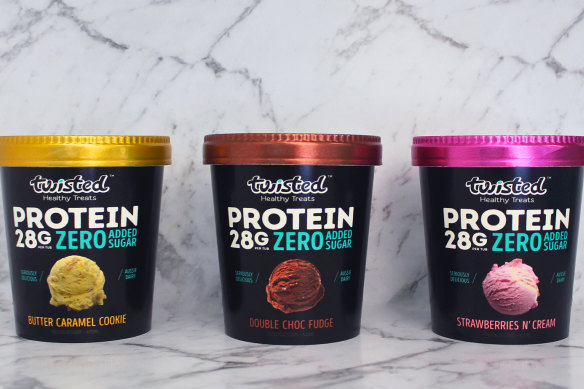
High protein
Protein is a buzzword in supermarkets, with foods often promoted for their high-protein content due to the nutrient’s positive association with health and wellbeing. This has resulted in a number of higher protein dessert options that are made with a concentrated milk base to increase the amount of protein. They are then sweetened with natural sweeteners to create a lower-calorie, higher-protein dessert option. While a higher protein dessert sounds like a good option nutritionally, they target a very specific segment of the market and at a relatively high price point, so do not always survive the brutal competition in supermarkets.
Dietitian’s thoughts
An option for those actively seeking more protein from their dessert and who are happy to spend a little extra to get it. Be mindful that high protein does not equate to less processed.
Common brands: Twisted Healthy Treats, YoPRO, Gym Bod
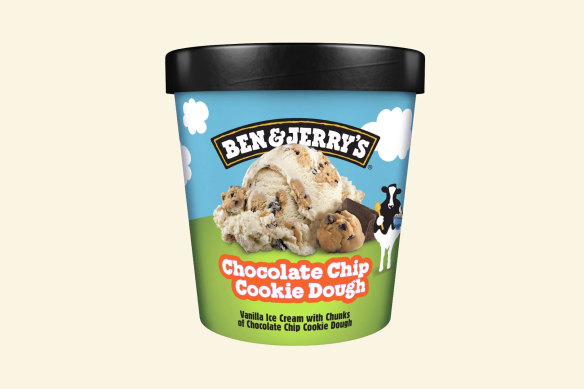
Dairy desserts
While some of these more indulgent varieties are still “ice-cream”, in reality they are more like confectionery in a dessert tub, combining chocolate, a little dairy, cake and extra sugar to create a flavour sensation for the mouth but one that also comes with plenty of calories. With 10 to 20 per cent added fats and often upwards of 30 per cent sugars thanks to the extra treats they contain, these options are more of an occasional treat than a daily diet addition.
Dietitian’s thoughts
If you see confectionery in your dessert, think of it like eating chocolate, lollies or cake – it is party food.
Common brands: Ben & Jerry’s, Cadbury, Magnum

Gelato
Unlike the word “ice-cream”, which is regulated in Australia, there are no such regulations for gelato, which is generally lower in fat than ice-cream, thanks to its fruit or skim milk base. There is a wide range of gelato options available, some made with a simple mix of fruit and sugars, which results in a low-fat, high-sugar sweet treat that is upwards of 20 per cent sugars. The more decadent the gelato and the greater the number of high-fat additions such as biscuits or chocolate bits, the higher the calorie and fat content, so opting for plainer varieties will keep your calorie intake down.
Dietitian’s thoughts
A good quality gelato, with minimal ingredients, can be a lighter alternative to ice-cream.
Common brands: Gelativo, Gelatissimo
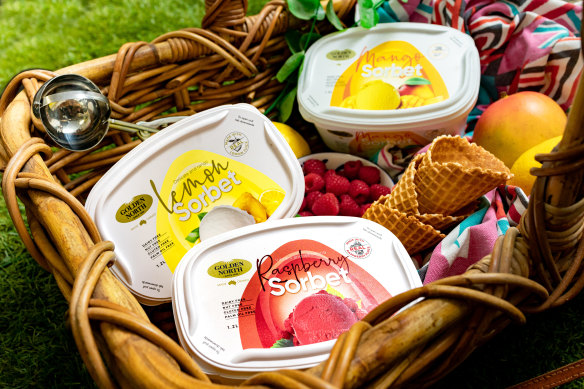
Sorbets
Less popular that ice-cream or gelato, sorbets are nevertheless available in most supermarkets, and are made from a mix of water and fruit to create an icy, low-fat, relatively high-sugar treat. While a base mix of fruit and water is relatively healthy, the downside is that commercial sorbets often contain a range of added sugars and additives, increasing the overall sugar content to 30-plus grams per 100g serve. For those who need dairy- or gluten-free dessert options, or who cannot eat eggs or nuts, sorbet may be a suitable option.
Dietitian’s thoughts
In theory, a fruit sorbet is healthy, but most commercial varieties are based on sugar rather than fruit. If you love frozen fruit, make sorbet at home by blending fresh or frozen fruit with a little ice.
Common brands: Weis, Golden North
What is the best option nutritionally?
It’s difficult to compare different desserts as we’re not comparing like for like. Full-fat ice-cream, for example, is very different to a protein-based dessert, which is different again to sorbet. When it comes to a balance between a creamy, minimally processed product and nutritional profile, overall, a plain gelato is lower in fat than ice-cream, while offering a similar taste and texture. But you also can’t go wrong if you enjoy a scoop or two of real ice-cream now and then.
The best recipes from Australia's leading chefs straight to your inbox.
Sign up